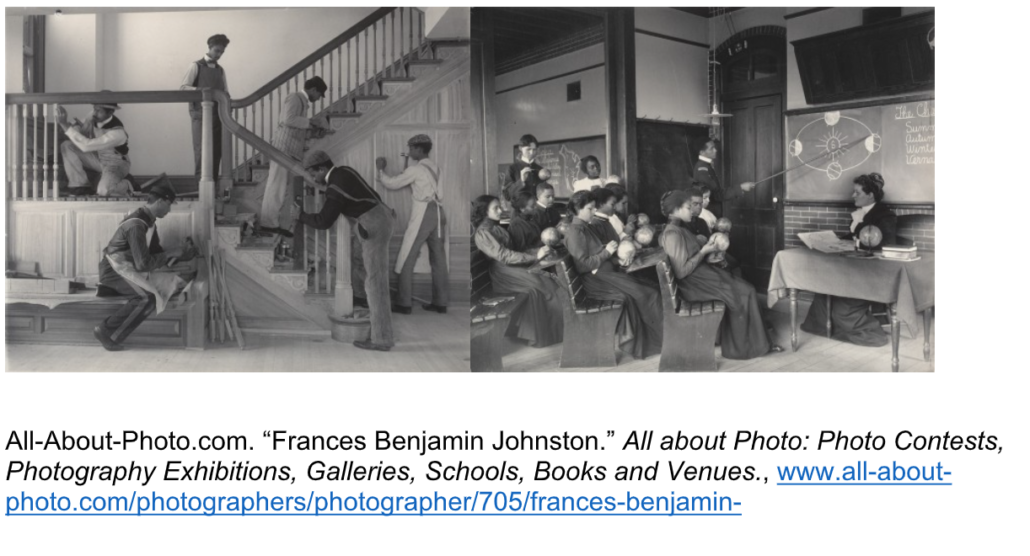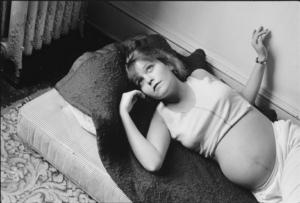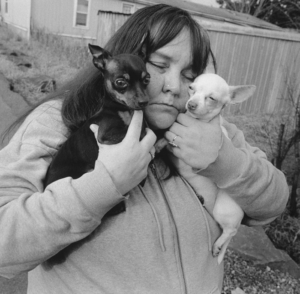Three Women Photographers. catching moments. changing minds.
An image can be a powerful way to evoke emotion and thought.
This website will explore the works of three photographers who influenced the way American history was documented from 1880-2000. Their photographs made an impact by not only recording moments but also changing the direction of history by exposing some hard truths and opening minds.
Francis Benjamin Johnson
1864-1952
Biography
Frances Benjamin Johnston was one of the first female press photographers in the United States (Moma.org). She captured photographs of hundreds of subjects, ranging from architecture to political figures. Johnston used her prominence in the photography world to spread the messages that she thought needed to be shared with the world. Her career began when she was young, and she eventually became the go-to photographer for portraits of prominent people of her time. Later on in her life, she began to focus more on architecture rather than news events and portraits. Rather than new, lavish architecture, she focused her work on the old, deteriorating buildings of American society to bring attention to their state and what these buildings meant to US history. As Johnston’s career began to take off, she was commonly asked to travel in order to photograph. Examples of this are “White House Kitchen” and “ Students at Work on a House Built Largely by Them” featured below.
"Victorian Womanhood in All Its Guises"
 Through her self-portraits, Frances Benjamin Johnston portrayed herself as a woman who could be both ladylike and nonconformist. These traits fueled her career. These two portraits were not Johnston’s most popular works but were arguably her loudest. She used her photography to show the two sides of womanhood in the Victorian Era and to argue that
Through her self-portraits, Frances Benjamin Johnston portrayed herself as a woman who could be both ladylike and nonconformist. These traits fueled her career. These two portraits were not Johnston’s most popular works but were arguably her loudest. She used her photography to show the two sides of womanhood in the Victorian Era and to argue that
rather than having to pick a side, woman should be able to be individuals. The photo on the
left shows her in a more nonconformist way, bringing into light the stereotype that women
who dressed in a maverick way were too masculine. She has her legs crossed and her body
leaned forward, sitting like many men did, and is holding a beer stein and a cigarette.
Conversely, in the picture on the right, she portrays herself as a more feminine and socially
acceptable woman. She is showing her whole face, wearing more feminine clothing, and is
sitting in a proper way. She is showing her audience that women can be multifaceted and
don’t need to conform to the ideals of society."Victorian Womanhood in All Its Guises"
White House Kitchen
“White House Kitchen”, taken by Frances Benjamin Johnston in 1891, features Dolly Johnson in the White House kitchen. President Harrison and his wife fired their French chef and hired Dolly Johnson in 1889. Dolly Johnson, a free black woman, was originally from Louisville, Kentucky, but worked for the Harrisons in Indianapolis before his presidency. This move by President Harrison was a huge turning point in history, as black chefs were rarely recognized or even seen, “doing their thing, hiding in plain sight” (Washingtonpost.com) Johnson stayed on after Harrison’s time in office and worked for President Cleveland for around a year. He fired her, but later tried to rehire her and she refused. Dolly Johnson moved back to Kentucky and went on to successfully open multiple restaurants. This photograph and Johnsons story is a great example of her use of photography in the Civil Rights Movement.
This photograph brings to light the fact that Frances Benjamin Johnston was a woman of many talents. Johnston was part of the feminist movement not by campaigning or attending rallies, but by breaking domestic role expectations and walking the walk. She used photography to support herself. This photograph is an interesting example of how many places Johnston was asked to travel to and photograph.
The Hampton Album
 Throughout her career, Frances Benjamin Johnston received some grants to document Virginia’s early architecture. One of those grants was to photograph the Hampton Institute. The goal of these projects was to encourage people to preserve buildings like the Hampton Institute that were slowly but surely being knocked down and deteriorating. The photographs shown of the Hampton Institute feature students posed as if they were living their everyday lives. Johnston used glass plate negatives, meaning her camera’s exposure time was multiple seconds, and her subjects needed to stay absolutely still. She posed the students exactly how she wanted them shown rather than taking candid photos. Johnston’s collection of photos of the Hampton Institute was put into the “American Negro Exhibit” at the Exposition Universelle in Paris in 1900 (moma.org). The exhibit was organized by W. E. B. Du Bois, a civil rights activist, and Thomas Calloway, a lawyer, and it showed viewers the progress that African Americans had made since the Civil War (moma.org).
Throughout her career, Frances Benjamin Johnston received some grants to document Virginia’s early architecture. One of those grants was to photograph the Hampton Institute. The goal of these projects was to encourage people to preserve buildings like the Hampton Institute that were slowly but surely being knocked down and deteriorating. The photographs shown of the Hampton Institute feature students posed as if they were living their everyday lives. Johnston used glass plate negatives, meaning her camera’s exposure time was multiple seconds, and her subjects needed to stay absolutely still. She posed the students exactly how she wanted them shown rather than taking candid photos. Johnston’s collection of photos of the Hampton Institute was put into the “American Negro Exhibit” at the Exposition Universelle in Paris in 1900 (moma.org). The exhibit was organized by W. E. B. Du Bois, a civil rights activist, and Thomas Calloway, a lawyer, and it showed viewers the progress that African Americans had made since the Civil War (moma.org). The Hampton Album
Dorothea Lange
1895-1965
Biography
“A camera is a tool for learning how to see without a camera.”– Dorothea Lange, A Life Beyond Limits
Dorothea Lange is considered one of the greatest documentary photographers of our time. She is widely known for her iconic photo “Migrant Mother” taken while she was documenting the Great Depression for the Farm Security Administration (1930-1939), her work for the War Relocation Authority photographing the Japanese Internment and also her advertising photos.
Dorothea started developing her eye for photography when she was nine years old using her Box Brownie Camera. During her teen years, she spent her time walking the city of New York and studying the work of Isadora Duncan. Ms. Duncan’s success in breaking into and succeeding in the arts was inspirational to Lange and she decided to study photography. She attended Columbia University to study photography. She took her studio art to the streets during the Depression. LAter in life she continues to study earning a BFA in painting and art history from the University of Pennsylvania, and finally a Masters Degree in photojournalism from U of P’s Annenberg School for Communication in 1964. In 1965, she received a Fulbright Scholarship to travel throughout Turkey taking photographs. She never stopped ‘developing’.
Dorothea had an eye for exposing the hard to look at. Her work was very prolific but here we will concentrate on her coverage of poverty in America during the Great Depression, the Japanese Internment and her commercial work which was used for propaganda. In the case of the Internment photos, had they been able to have been seen at the time, they would have been a voice for those unable to speak for themselves. Dorthea’s photos documented many times in history we as a nation were afraid to see.
"Migrant Mother"
“Migrant Mother”, taken by Dorothea Lange in 1936 is one of the most important photos in American History. This photograph was taken at a camp of migrant farmworkers in Nipomo, California. The photo features an impoverished woman and her two children, and it showcases the extremely hard lives of many Americans during the Great Depression. Lange used her platform to showcase the struggle of Florence Owens Thompson and her children in particular. Thompson was 32 at the time, and hungry and desperate she agreed to help Lange with her work. After the photograph was taken, Lange told the editor of a San Francisco newspaper about the lives of the people in this camp and, in response, aid was rushed to the camp to prevent famine (pbs.org). This event is a great example of how powerful one photograph can be. From this moment in history, the photograph has been iconic. It’s become a visual representation of depression for many people as well as an image representing an “ultimately invincible nation enduring a terrible collective tragedy”(Gordon 238).
"Migrant Mother"
April 20,1942 - San Francisco
Japanese internment camps were created during World War II after the Pearl Harbor bombing by President Franklin D. Roosevelt. Roosevelt put order 9066 in place to keep any one of Japanese descent in isolated camps (History.com). These dehumanizing camps were inhabited by 117,000 people who were American citizens (History.com). Dorothea Lange was hired by the government to photograph these camps and her belief that “a true record of the evacuation would be valuable in the future.” Would prove to be correct in the future (anchoredititons.com). The photographs that she took exposed the wrongdoings of the American government and were seized by the government for the remaining years of World War II (anchoredititons.com). Because the military seized these photographs, they have been very rarely seen. But they are extremely important. This picture in particular displays American children of Japanese descent at Raphael Weill Public School in San Francisco California (anchoredititons.com). These children were eager learners whose educations were disrupted by their evacuation to internment camps. It important that Lange took these photographs because, without them, the dehumanizing actions taken by the American government in this situation would be less known.
"This is America"
This photograph was part of a series of posters created by the Sheldon-Claire Company, a Chicago ad agency to advertise the perfect American family and ideal postwar America. This is an example of how photographs perhaps taken for one purpose by the photographer can be used for another purpose commercially. Usage and copyright issues are something photographers still deal with today. Once the rights are purchased owners can decide how to use the photograph and that may not always be in line with the beliefs and ideologies of the photographer or consistent with the reason the photo was taken.
"This is America"
An Interview About Dorothea Lange - from NPR with permission
The Famous Camera of the Famous Picture
The Famous Camera of the Famous Picture
Mary Ellen Mark
1940-2015
Biography
Mary Ellen Mark started developing her eye for photography when she was nine years old using her Box Brownie Camera. This interest developed into a BFA in painting and art history from the University of Pennsylvania, and finally a Master’s Degree in photojournalism from U of P’s Annenberg School for Communication in 1964 (Grimes). In 1965, she received a Fulbright Scholarship to travel throughout Turkey taking photographs (Grimes). She took some of her inspiration throughout her career from the previously mentioned Dorothea Lange. Mary Ellen Mark used her photographs to showcase the tough topics that others tended to avoid. Her pictures of and empathy towards homeless teenagers in Seattle and mental patients in Oregon made her one of the most famous photographers of her time. She published multiple books throughout her career featuring her photographs. Mary Ellen Mark used her talents to show people things about their country that they might not have otherwise seen.
"Tiny" at 14 and as an adult
In 1983, Mary Ellen Mark as in Seattle shooting photographs of the kids she found on the street for Life magazine (latimes.com). While she was there, she met “Tiny”, a 14-year-old girl who had run away and become a prostitute. After she original visit, Mark went back to Seattle to take more pictures of Tiny, and eventually captured a collection of photos of Tiny’s life from that first photo in 1983 all the way until 2014. This collection features over 10 photos of Tiny throughout her life, capturing the emotions that people usually tend to hide. The pictures show Tiny depressed, high, happy, and everything in between. The first photo shown is one of the most iconic photos of the collection, as it showed people what some of the kids that they saw on the streets had to go through in order to make a living and survive. Mary Ellen Mark showcased a woman that rose from one of the lowest points a person can experience. She pointed out that sometimes the people who have the least in life have the most strength and perseverance and can thrive with a little help from someone else. The second photo shown proves this. Tiny overcame all of the hurdle’s life threw at her and grew into a successful woman and mother. The collection shows its viewers Tiny’s journey, going from a pregnant young girl on the street to “a mother of ten who has overcome a serious drug addiction”(Furman). Without Mary Ellen Mark capturing these moments in Tiny’s life, her inspiring story would have never been known.
"Tiny" at 14 and as an adult
The Circus Photos
In 1969, Mary Ellen visited Bombay, India. She felt very at home there. During her first visit she took some photos of a circus. This turned into a major project. As Mark explained in 1987, “I’m just interested in people on the edges. I feel an affinity for people who haven’t had the best breaks in society. What I want to do more than anything is to acknowledge their existence”. (https://www.all-about-photo.com/photographers/photographer/138/mary-ellen-mark) Mary Ellen Mark was an expert at composing shots of unusual characters that the viewer was not only mesmerized by but could in some way find a connection to no matter how different the lives of the subject and the viewer.
Celebrities and Movie Documentation
Mary Ellen Marks affinity for photographing the bizarre, unusual and disenfranchised human paradoxically made her a genius at taking pictures of celebrities and documenting the shooting of films. She was able to see their essence. The first photo here shows Ansel Adams in his element practically becoming one with his camera. Anne Hathaway is shown here in her role in Alice in Wonderland and the composition, complete with a live mouse, takes care to communicate that strange magic of the story. Lastly, Maya Angelou, here reflecting on a picture of her younger self speaking to all the writings she has done about herself growing up as a young, African American woman. Marks’ view of the world was so broad, her view of humanity so deep that her portraiture became elevated. (www.maryellennmark.com)
Celebrities and Movie Documentation









